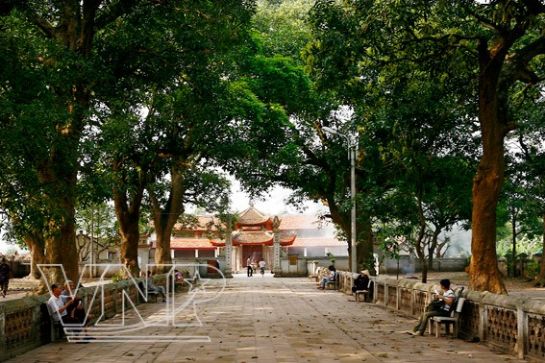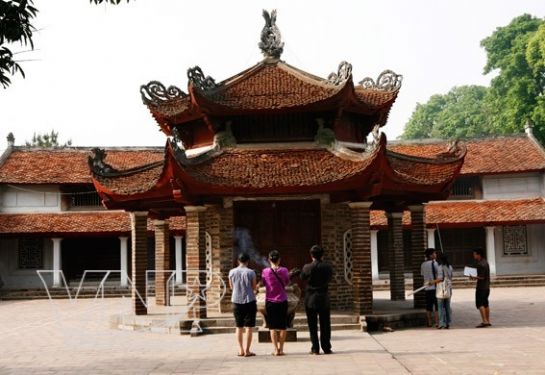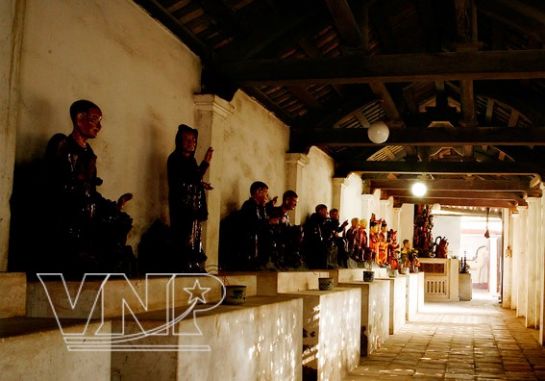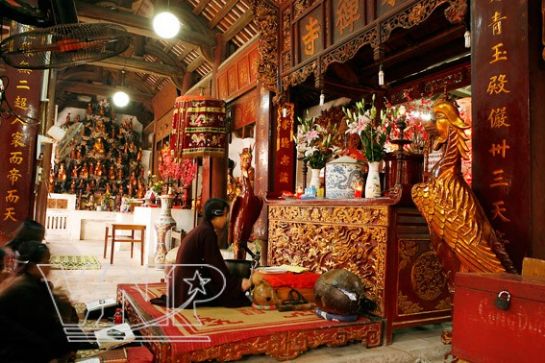Lang Pagoda in Hanoi
Published: 27/10/2012 02:17
Lang Pagoda, also called Chieu Thien Pagoda, is located on the land of the old Lang Village (present-day Lang Thuong Ward, Dong Da District, Hanoi ), 6km west of the city centre. The Pagoda was built in the 12 th century under King Ly Anh Tong’s Dynasty (1138-1175) to worship Buddha, King Ly Than Tong (who reigned from 1128 to 1138) and Buddhist monk Tu Dao Hanh – a famous monk during the Ly Dynasty.
According to the legend, Buddhist monk Tu Dao Hanh reached the peak of his holiness and extraordinary magic. He died at Thay Pagoda and then was reincarnated as the son of Sung Hien Hau (younger brother of King Ly Nhan Tong). King Ly Nhan Tong didn’t have a son so he conferred the title of crown prince on Sung Hien Hau’s son who later became King Ly Than Tong. When King Ly Than Tong died, his son, Ly Anh Tong, ordered the construction of Chieu Thien Pagoda in memory of his father. Lang Pagoda is a large harmonious symmetrical architectural complex with an airy space and has 100 compartments. It was once considered the first pagoda in the west of Thang Long Imperial City. The Pagoda has retained many precious objects of historical and artistic values, such as the stele “Tao Le”, 1.4m high and 0.8m wide, erected in the 4th year of Thinh Duc (1656) with delicate patterns, Phuc Dien stele and 13 others from King Tu Duc’s Dynasty to King Bao Dai’s Dynasty. It has also preserved ancient tablets of the Le, Tay Son and Nguyen dynasties, 30 panels, 31 couplets, a big bell and a great bronze plaque cast in the year of Mau Ngo (1738), etc. Of particular interest, in the inner harem exists the statue of Tu Dao Hanh that was made from rattan and red-lacquered. According to a research, based on the graphic strokes and layers of paint observed at the slits on the statute, the statue dates back to the Le Dynasty. According to a researcher from the Centre for Southeast Asian Prehistory Research, the two layers of cloth used to make the statue are dated hundreds of years apart and the bronze around the statue’s core is of the early Bronze Age. Inside the statue there are seven ancient coins with the scripts recording the name of the dynasty and an ancient bronze mirror. Prof. Doctor Do Van Ninh said that these coins were cast in 1644-1646 which are also mentioned in records in the stele on “the Management of Chieu Thien (Lang) Pagoda”.
|
Provide by Vietnam Travel
Lang Pagoda in Hanoi - | vietnam travel company
You can see more
- “Sac bua” singing recognised as national intangible cultural heritage
- Market Culture in Vietnam
- Hung Kings worship, source of nation's strength
- Honoring Hung Kings’ worship rituals
- Forging craft of Nung ethnic people in Cao Bang
- Foreign tourists go to Vietnam to… eat, why not?
- Lam Kinh Back to origins of the later Le Dynasty
- Perfume Pagoda pilgrimage
enews & updates
Sign up to receive breaking news as well as receive other site updates!
- Banh Đa Cua - a traditional Hai Phong specialty
- Exploring Lai Chau cuisine
- Hanoi ranked top 3 cuisine in the world in 2023
- Beautiful resorts for a weekend escape close to Hanoi
- Travel trends in 2023
- In the spring, Moc Chau is covered in plum blossoms.
- The Most Wonderful Destinations In Sapa
- Top 3 Special festivals in Vietnam during Tet holiday - 2023
- 5 tourist hotspots expected to see a spike in visitors during Lunar New Year 2023
- How To Make Kitchen Cleaned
-
vietnam travel
http://www.vietnamtourism.org.vn " Vietnam Tourism: Vietnam Travel Guide, Culture, Travel, Entertainment, Guide, News, and...
-
Vietnam culture, culture travel
http://travel.org.vn " Vietnam culture
-
Vietnam travel, vietnam travel news, vietnam in photos
http://www.nccorp.vn " Vietnam travel, vietnam travel news, vietnam in photos
-
Vietnam tourism
http://www.vietnamtourism.org.vn " The official online information on culture, travel, entertainment, and including facts, maps,...
-
Vietnam Travel and Tourism
http://www.vietnamtourism.org.vn/ " Vietnam Travel, Entertainment, People, Agents, Company, Vietnam Tourism information.
-
Information travel online
http://www.travellive.org "Information travel online
















